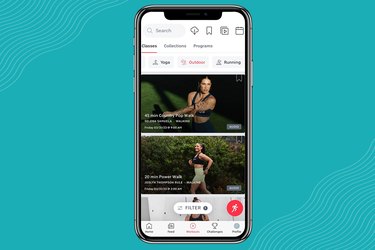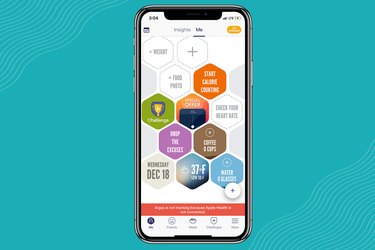
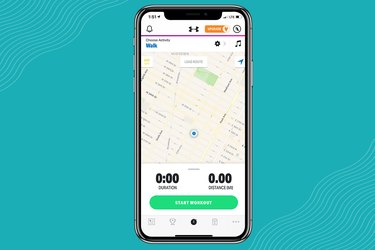
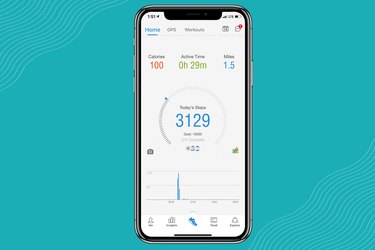
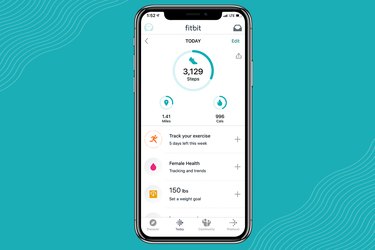
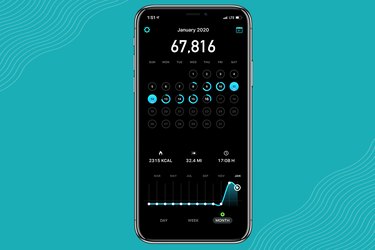
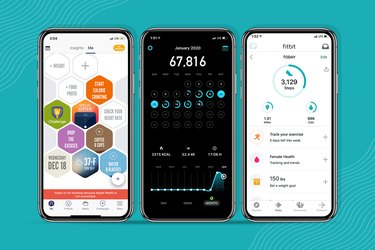
Walking is one of the best workouts you can do. What's makes it even better? Tracking it in a walking app.
Apps for walkers allow you to map your strolls, log your steps and share your progress with friends. That means more motivation, better consistency and crushed fitness goals. Bonus: These apps are usually free.
Video of the Day
Video of the Day
But with seemingly endless options out there, I had no choice but to max out my phone storage and download them all. (Well, at least a bunch of them.) Many, many steps later, I've narrowed down the five best walking apps that can help you increase your daily step count.
Warning
Keep safety in mind before you set out on your first app-guided walk. Be cautious of traffic — if you're wearing headphones, keep the volume moderate or leave one earbud out — watch for pedestrians and keep a water bottle handy.
How We Chose
We personally tested some of the best-rated walking apps available in the Apple and Google Play app stores, taking them out for walks and connecting them to our various devices. Then, we narrowed down our choices based on the following criteria:
- Performance
- Features
- Price
- Ease of use
The Best Walking Apps
- Best Overall: MapMyWalk (iOs, Google Play)
- Best for Health: Pacer (iOs, Google Play)
- Best for Step Tracking: StepsApp (iOs, Google Play)
- Best for Walking and Meals: Argus (iOs, Google Play)
- Best for Gadgets: Fitbit (iOs, Google Play)
- Best for Guided Walks: Peloton (iOs, Google Play)
1. Best Overall: MapMyWalk by Under Armour
With a 4.8-star rating in the Apple app store, the consensus on this walking app is pretty clear. After several test runs (or rather, walks), I'd have to agree. MapMyWalk is easy to use, allows for plenty of customization and makes your data simple to analyze.
Interface
Most popular walking apps open to a dashboard, but MapMyWalk opens up right to a map and a Start Workout button. It's ready to go whenever you are.
The walk duration and distance are prominently displayed on the screen, and it's easy to switch from page to page using the navigation at the bottom of the screen.
Tracking
The variety of data this app offers sets it apart from its competition. As you walk, you can check your time, distance, pace, stride length, cadence and calories burned. After you're finished with your workout, the app lets you snap a picture or jot down a few notes on how your workout went — my personal favorite element because I just love to share sweaty selfies with my friends.
After your walk is done, you can also find your total step count and any elevation changes. You can even compare all your previous walks on an easy-to-read chart.
If you're a fan of setting goals, MapMyWalk lets you to create your own challenges, like walking a mile per day. You can select the activity, the challenge type (most steps, most workouts, most distance, most calories burned, etc.), and the duration and dates of the challenge. Plus, you can even invite friends to join in if they're using the app, too!
Customization
Another perk of MapMyWalk is how customizable it is. The app can track 20 different activities that can you can fully personalize. If you choose to track a walk, for example, you can specify if you were stair walking, treadmill walking, dog walking, outdoor walking or power walking.
You can also enable voice feedback for audio updates on your distance and pace or customize the stats displayed during your walk.
MapMyWalk can also sync with a variety of fitness trackers and even connect to other apps on your phone.
Download it: iOs, Google Play; Price: free (basic); $5.99/month or $29.99/year (premium)
2. Best for Health Tracking: Pacer
If you're looking to track not just your walks but also overall health data, check out Pacer. In addition to its built-in map and GPS features, it has tools to log your food, weight, blood pressure and more.
Interface
The Pacer walking app opens up to a personal dashboard, which shows how many steps you've taken, how many calories you've burned, how much time you've spent being active and how many miles you've completed that day.
It also offers navigation at the bottom of the screen where you can explore challenges and groups hosted on the app.
Tracking
Pacer allows access to a number of data points in its free version, including your total steps, calories burned, active hours and miles logged.
The app also tracks some more general health metrics like your weight, blood pressure and flights of stairs taken, which you can compare over time in a bar graph. In the paid version, you'll also get to track your weight trends and personal record progress, among other benchmarks.
Customization
Pacer's customization is a bit limited. In the app's settings, you're able to adjust your units of measurement and set up push notifications to remind you to get more steps or log your weight or workouts. Pacer also lets you set personal step goals.
The majority of Pacer's app-based workout videos are available only with a paid subscription. And while the app lets you log a variety of activity types, it doesn't track these workouts. For instance, you'll need to manually enter your duration, distance and calories burned if you're running, swimming or biking.
Download it: iOs, Google Play; Price: free (basic); $9.99/month or $49.99/year (premium)
3. Best for Step Tracking: StepsApp
Much simpler in design than the other best walking apps on this list, the StepsApp is exactly as it sounds: an app that tracks your steps. Anyone looking for a simple, to-the-point, pedometer-style app will likely be happy with what it has to offer.
Interface
StepsApp gets right to the point and opens up to a page displaying your steps taken and your daily step goal. You'll also see how many calories you've burned, the distance you've crossed and how many active minutes you've racked up. The bottom of the page also breaks down your activity in a bar graph by the hour of the day, displaying when you were most active.
You can change that homepage's settings to scroll through your activity for the week and month instead of the day.
As the app really only consists of one page, it's simple to use. FYI, the background is a black, which is a change-up from most apps for walkers.
Tracking
StepsApp offers the most limited data in its free version, tracking only the three data points on the homepage. However, if you decide to upgrade, you're able to track your calories, sync with your Apple Watch, import your iPhone health app data, analyze your activity trends and get an hourly overview of your daily steps in widget form.
Customization
As this app is really only for tracking steps, there's little you can change. But you can customize your step length and the units used in the app.
Download it: iOs, Google Play; Price: free (basic); $4.99/month or $19.99/year (premium)
4. Best for Tracking Walks and Meals: Argus
With a unique and interactive design, Argus is great for anyone looking to upgrade their working app with meal tracking and other health metrics. It allows you to track not only your steps but your calories, water intake and meals.
Interface
Although Argus probably offers the most unique homepage of the walking apps I tried, it's also one of the more confusing to navigate, as it's highly interactive.
Argus displays information like steps, calories, water tracking and the weather in bubbles, which you can customize and rearrange to your liking. As an organizational lover, I'd recommend arranging by color to create a rainbow effect — but that's just me.
As with other apps for walkers, you can scroll between pages — like your dashboard, friends, meals, challenges and profile settings — at the bottom of the screen.
Tracking
Argus' insights page shows several data points like your daily active minutes, sleep duration, daily calories, steps and workouts per week. The app also lets you track your weight, water intake and heart rate (measured using your phone's camera).
Aside from walking, Argus lets you track your runs, including your pace, time and distance. The app also offers a food diary and meal plan option, allowing you to pick the best meal plan for your goals.
Customization
The Argus homepage is its most customizable feature, enabling you to rearrange data points however you like (yep, you just drag the little bubbles across the screen). The app is also great for personal goal-setting, as you can set up your own water, sleep, calorie, exercise and weight-loss targets.
Download it: iOs, Google Play; Price: free (basic); $9.99/month or $29.99/year (premium)
5. Best for Gadgets: Fitbit
The Fitbit app easily connects with a bunch of devices, not just Fitbit watches. But you don't have to own a tracker to use this app. Fitbit is great for tracking your progress over time, as it can import data from other walking apps you're using.
Interface
Fitbit's app is easy to use and navigate. All of the most important metrics are the first to pop up on the home screen, including the steps you've taken, the miles you've clocked and the calories you've burned.
You can scroll between a few different pages in the app using the navigation options at the bottom of the screen.
Tracking
The app tracks a variety of metrics, including your step count, calories burned, miles walked, current weight, exercise, water intake, food and menstrual cycle. Each of these can also be viewed on a line graph, which lets you easily assess your progress over time.
Exercise options are a little sparse; you can only track walking, running or hiking directly in the app without a separate fitness tracker. But if walking is your thing, the Fitbit app uses GPS to track your location on a map; you can turn on audio cues to update you on your time, pace and distance.
Customization
In Fitbit's free walking app, you can personalize your daily goals for steps, distance walked and calories burned. You can also edit your exercise goals and food intake or ideal body weight and fat percentage.
The Fitbit app is compatible with all Fitbit devices and a variety of other apps, which is key to its appeal. If you're a fan of RunKeeper, for instance, you can easily sync that data with Fitbit.
Download it: iOs, Google Play; Price: free (basic); $9.99/month or $79.99/year (premium)
6. Best for Guided Walks: Peloton
You don't need a bike or treadmill to reap the benefits of the standalone Peloton app, which includes Outdoor Walks as part of its vast library of classes. A trainer will guide you through a walking workout to get to the most of your steps.
Interface
Peloton first became famous for its top-of-the-line home spin bike, but its app — which offers on-demand classes in walking, running, biking, strength, yoga, meditation and more — has emerged as one of the best fitness apps around.
The interface is clean and easy to maneuver. Applying a few simple filters helps you narrow down your options to outdoor walks or even walking workouts on a treadmill. These workouts are lead by Peloton trainers and usually have different themes, either by music, time or difficulty.
The home page also tracks your number of workouts and how many times you've done a class this week, and usually includes an encouraging message to get you started.
Tracking
The app itself won't track your precise steps, but at the end of a workout, it will show you your stats. And if you've connected a watch, heart rate monitor or other fitness tracker, it can sync to the Peloton app.
The app also tracks how many Peloton workouts you've done overall, and you get "streaks" for working out a certain number of days or weeks in a row.
Customizations
Personalization of the Peloton app is pretty low, but if you use it enough, over time it will start recommending classes based on your favorite instructors or your common choices (so, if you love 30-minute walks with Jess Sims, you'll start to see those recommended on your home page.)
It also connects a variety of heart rate monitors to help track your heart rate and effort during workouts, which Peloton calls your Strive Score.
Download it: iOs, Google Play; Price: $12.99/month
Was this article helpful?
150 Characters Max
0/150
Thank you for sharing!
Thank you for your feedback!
